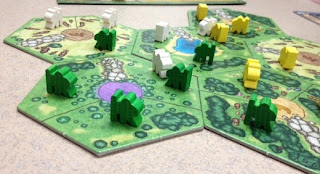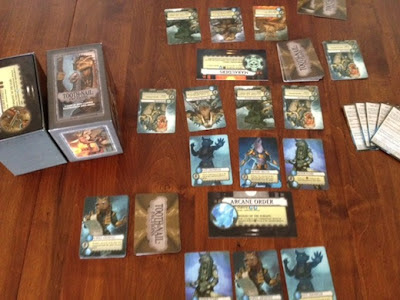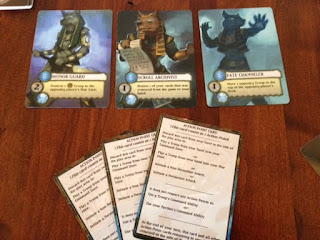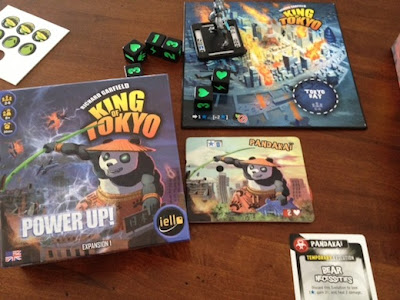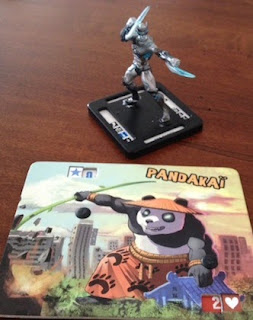Sometimes a game's box doesn't immediately attract your attention, but something else causes you to try it out. For me,
Keyflower was a perfect example of this.
In Keyflower, you play a series of four rounds ("seasons"). Each round is a combination of auctioning and worker placement. Going around the table, each player has the option of placing workers. These workers can be used to bid (or increase a bid) on a tile, or they can be played on top of a tile to activate its effect. At the end of each round, players take any tiles that they have won, and they connect them to their village (previously purchased tiles). That is the crux of the game. However, one action that can be performed is worth noting - tiles can be upgraded. By acquiring goods (and moving them (another action) to the correct locations), players can upgrade their existing tiles to make them better - either they will have a stronger effect, they will be worth more points, or both. At the end of the four rounds, whoever has the most points wins.
So, to be fair, there are a lot more rules than the very trim overview that I just gave. And one specific rule leads to my first pro. Each tile can be bid on (and/or activated) by only one
color of meeples ("miniature peoples"). What does this mean? There are three basic colors of meeples - red, blue, and yellow (there are also green meeples, which are harder to get). Each player will have a varied number of these meeples, and they will use them to bid on tiles. So, when I bid on a tile, I might bid one
yellow meeple. If someone else wants to overbid me later, they have to bid more
yellow meeples than I bid - they can't use green, red, or blue. This causes a really interesting dynamic in the game. Sometimes you want to have an even distribution of colors - that would let you bid on anything, and you won't have to worry about what other players bid. Other times it might be in your best interest to have a whole lot of one color. This would let you be much more likely to win a tile that you really want - assuming that you're able to set the color on it.
 |
| Bidding in yellow meeples |
The next pro is that owning a tile isn't always better than not owning it. Why? Because
anyone can activate your tiles - not just you. And, when activating a tile, whoever activates it first selects what color is used for activating it. So, if I have a lot of red meeples, and you have a tile that I really want to activate several times, then I might choose to activate it with red meeples (each additional activation costs an extra meeple; and each tile can only be activated up to three times per round). And, since I placed red meeples on your tile, I may have prevented you from being able to use your own tile! (That is, assuming you don't have any red meeples.) Now, at the end of the round, you get to keep any meeples that were played on your tiles, which can be wonderful. But that isn't always better than getting to activate your own tile, specifically on the last round of the game. So, whereas it is very good to own tiles (you can at the very least control things like when it is upgraded), it is sometimes much better to go first! (And, of course, you get to go first if you win the auction that determines who goes first.)
My third pro for Keyflower is that the game has a very tense feeling. What I mean is that often during the game I will want to perform about five actions on each turn. And, I'm actively waiting on my opponents, hoping that they won't do "that one thing" that I need to do. Which, inevitably, they will do. One of the marks of a good game is that you are forced to decide the "better" move between two good moves. And, in my opinion, Keyflower nails that characteristic.
The final pro that I will mention is how the fourth round ("winter") works. At the beginning of the game, each player is given a few different winter tiles. Before the start of winter, each player has to select which of their tiles (at least one) will be available for auction that round. So, you have some control over what will be worth victory points. Or, probably more truthfully, you have some control over what
will not be worth victory points - by burying the tiles that would be most beneficial to your opponents. Granted, just because you select a tile doesn't mean that you will actually keep it - you still have to win the auction. But, I like that the final scoring tiles are determined by player selection instead of random chance.
 |
| Meeples waiting to be collected |
Though there are not very many cons that come to mind for Keyflower, I will mention this one: the game can be negatively affected by the random tiles that are used in a given game - especially with a smaller number of players. Each game you use a different random selection of tiles. Great - replayability! However, depending on which tiles appear, certain elements of the game can be neglected. For example, if no tiles are drawn that allow you to create green meeples, then this very important aspect of the game will be completely missed. (Granted, this is not a common situation; I did, however, play a game where only one of these tiles was drawn - and that one was drawn in the last possible season.) Additionally, if the tiles that allow you to collect certain types of resources are not drawn, then you will have a hard time upgrading many of your tiles. These situations are not common, but with less players (the less players in the game, the less tiles you use), they can definitely happen.
My other (very minor) con for Keyflower is that it is difficult to quickly see what is happening. Since everyone is bidding with the same thing (colored meeples), and colors are not associated with players, it takes a second to register where you are bidding, what you are winning, and where you might want to play. (If you're wondering, you bid by placing your meeples on the side of the hexagonal tile that faces you.) This is a small price to pay for the incredibly well executed auction mechanic, but it is a nuisance nonetheless.
Overall, I give Keyflower a 9.0/10. It is one of the most pleasant surprises that I've found recently in gaming, and I think it will stay in my collection for quite some time. (And, hopefully I will get at least decent at it - I never win!)
If Keyflower sounds interesting, you might also check out
Kingdom of Solomon,
Legacy: Gears of Time, and
Power Grid.
I would like to thank Game Salute for providing me with a review copy of Keyflower.




